Trosa Boat-building School...
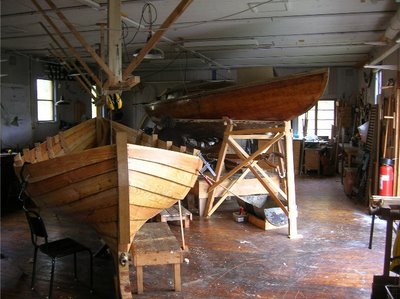 On a fine Friday afternoon, Ole and Annette invited me to join them on a trip to the Trosa Boat-building School about an hour south of Stockholm.
On a fine Friday afternoon, Ole and Annette invited me to join them on a trip to the Trosa Boat-building School about an hour south of Stockholm. Trosa, the little fishing town with its maze of centuries-old canals that we had visited on our way to Denmark in April, was much more green and lively now.
Trosa, the little fishing town with its maze of centuries-old canals that we had visited on our way to Denmark in April, was much more green and lively now. Little boats puttered up the canal against the current, squeezing past other craft and working their way up the 'S' turns toward the town center.
Little boats puttered up the canal against the current, squeezing past other craft and working their way up the 'S' turns toward the town center. There, in a little square surrounded by shops and cafes, the summer 'locals' gathered to soak up the small town feel and a bit of coffee. Having satisfied ourselves with this check-up on the town, Ole, Annette, and I drove out to the nearby peninsula that was home to the boat-building school.
There, in a little square surrounded by shops and cafes, the summer 'locals' gathered to soak up the small town feel and a bit of coffee. Having satisfied ourselves with this check-up on the town, Ole, Annette, and I drove out to the nearby peninsula that was home to the boat-building school.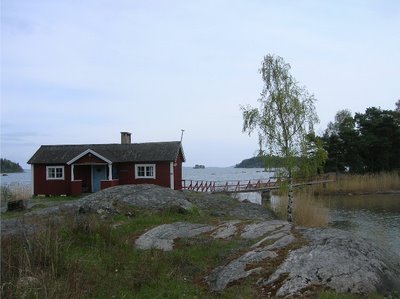 We walked down to the marshy edge of the Baltic, a littoral zone more akin to the Great Lakes' shorelines than that of a salty sea (although, not that salty. Only about 30% as much as the Atlantic or Pacific). The School had a nice little red boathouse out on an islet and it was there that we went to wait for the fleet.
We walked down to the marshy edge of the Baltic, a littoral zone more akin to the Great Lakes' shorelines than that of a salty sea (although, not that salty. Only about 30% as much as the Atlantic or Pacific). The School had a nice little red boathouse out on an islet and it was there that we went to wait for the fleet.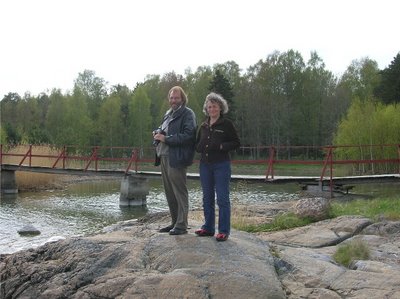 As a prominent member of the Scandinavian wooden boat world, Ole knows the head of the school quite well and had been invited down to meet the 'graduating class' as they completed their 'final exams'.
As a prominent member of the Scandinavian wooden boat world, Ole knows the head of the school quite well and had been invited down to meet the 'graduating class' as they completed their 'final exams'.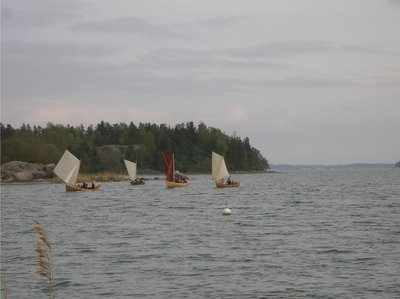 The final exam consisted of a week-long sailing trip through the Stockholm Archipelago aboard the craft they had spent the last 8 months building. We had the fine pleasure of watching the little fleet come bobbing around the point and skitter over the water towards the cove.
The final exam consisted of a week-long sailing trip through the Stockholm Archipelago aboard the craft they had spent the last 8 months building. We had the fine pleasure of watching the little fleet come bobbing around the point and skitter over the water towards the cove.The school is officially a Folkhögskol, or 'Folk High School'. It is a very common Swedish establishment for adults of all ages to attend for up to a year or two at some random point intheir lives--usually between jobs--and study some cultural art form be it music, dance, gardening, boatbuilding or whatever. It is a very uniquely Scandinavian kind of institution, reflective of the cultural philosophy for life-long self-improvement. Most people can get a sabbatical from their employer to take time for attending a Folkhögskol and they are curiously encouraging to employees wishing to take time off to learn the fiddle or synchronized swimming or whatever.
 Well, anyway, as they came closer we could see that a few had only 'scraped by on the final exam'. Some of the craft were pretty visibly unstable, slab-sided walnutshells with ugly sharp angles that flopped from port to starboard as they rolled over the wavelets. But for the most part, it was an impressive end-of-the-year achievement--especially for a group of people, few of whom had ever been sailing before, much less built a boat.
Well, anyway, as they came closer we could see that a few had only 'scraped by on the final exam'. Some of the craft were pretty visibly unstable, slab-sided walnutshells with ugly sharp angles that flopped from port to starboard as they rolled over the wavelets. But for the most part, it was an impressive end-of-the-year achievement--especially for a group of people, few of whom had ever been sailing before, much less built a boat.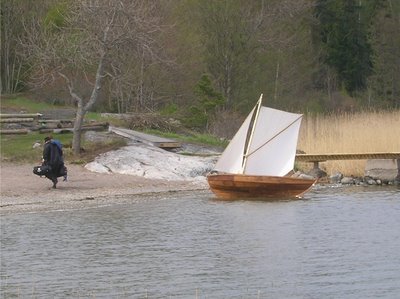 Sailing right in to the shore, they beagn beaching the little craft one by one. A few of the new sailors stepped out dripping wet--apparently not all the seams were caulked tight--and began to haul gear ashore. Regardless of any shortcomings they may have found in their craft during the passage, they were all having a great time. I've never met an unhappy boat-builder--especially one new to the craft.
Sailing right in to the shore, they beagn beaching the little craft one by one. A few of the new sailors stepped out dripping wet--apparently not all the seams were caulked tight--and began to haul gear ashore. Regardless of any shortcomings they may have found in their craft during the passage, they were all having a great time. I've never met an unhappy boat-builder--especially one new to the craft.
 Indeed, building a wooden boat with one's own hands, transforming those raw planks and a daydream into a vessel that can carry a person over the expanse of the sea, is an experience like no other, giving its maker a thrill all too few people know these days. It is a power and self-confidence, a bond with a creation, and an appreciation for handcrafts that no other practice or method can teach.
Indeed, building a wooden boat with one's own hands, transforming those raw planks and a daydream into a vessel that can carry a person over the expanse of the sea, is an experience like no other, giving its maker a thrill all too few people know these days. It is a power and self-confidence, a bond with a creation, and an appreciation for handcrafts that no other practice or method can teach. Shortly after the students began running their craft up on the beach, the professors hove in sight, lumbering their way down the channel in a larger, square-rigged Norwegian fishing boat.
Shortly after the students began running their craft up on the beach, the professors hove in sight, lumbering their way down the channel in a larger, square-rigged Norwegian fishing boat.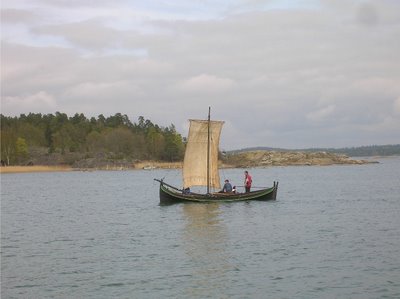 The wind was light but steady and they glided in effortlessly, leaving nothing more than a faint ripple astern.
The wind was light but steady and they glided in effortlessly, leaving nothing more than a faint ripple astern. ...such beautiful boats...
...such beautiful boats... After chatting with the 'graduates' for a bit, we left them to their unpacking and drying out while Ole, Annette, and I took to poking about the grounds, looking at the remains of long-abandoned skiffs in the bushes and the newly-built coastal fishing boats moored along the low, wooden seawall.
After chatting with the 'graduates' for a bit, we left them to their unpacking and drying out while Ole, Annette, and I took to poking about the grounds, looking at the remains of long-abandoned skiffs in the bushes and the newly-built coastal fishing boats moored along the low, wooden seawall. Some of them were really gorgeous constructions built with the finest wood and craftmanship.
Some of them were really gorgeous constructions built with the finest wood and craftmanship.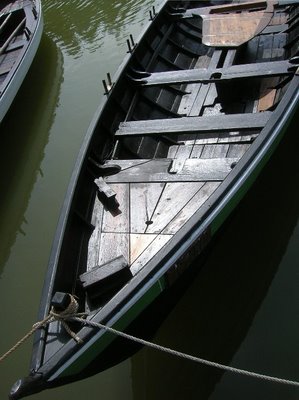 They glistened with new paint and fresh tar, the pine-pitch smell eminating from the decks warming in the sun and flavoring the entire boatyard.
They glistened with new paint and fresh tar, the pine-pitch smell eminating from the decks warming in the sun and flavoring the entire boatyard. One of the 'professors' (his joke) took us up into the loft of an old barn-now-boathouse where a number of craft were being stored, restored, or even built. The floor was covered with a soft layer of fragrant sawdust and wood shavings, the inseparablly timeless trademark of a wooden boat yard.
One of the 'professors' (his joke) took us up into the loft of an old barn-now-boathouse where a number of craft were being stored, restored, or even built. The floor was covered with a soft layer of fragrant sawdust and wood shavings, the inseparablly timeless trademark of a wooden boat yard. I poked about, admiring the workmanship in these craft, most of which were built a half century ago or more by true, master boatbuilders. There was no woodfiller to be found, no shims or wedges driven into unsightly gaps, nor any open joints. They were flawlessly constructed and although they had obviously been decayed by exposure to weather and time, these craft retained all their physical perfection to the top.
I poked about, admiring the workmanship in these craft, most of which were built a half century ago or more by true, master boatbuilders. There was no woodfiller to be found, no shims or wedges driven into unsightly gaps, nor any open joints. They were flawlessly constructed and although they had obviously been decayed by exposure to weather and time, these craft retained all their physical perfection to the top.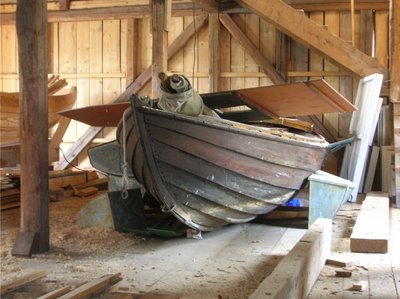 Then I was shown a particularly interesting craft. She was only 18 feet long, but her builder--a fairly famous guy in Swedish boat-building history--had taken her on an incredible voyage in the late 1940s. He started from Sweden, sailed along the southern coast of Norway, then across the violent North Sea to England. Next, he went overland by train to the Irish Sea and onward to Dublin. From there he kept going west, over Ireland to sail the fabled Galway Bay.
Then I was shown a particularly interesting craft. She was only 18 feet long, but her builder--a fairly famous guy in Swedish boat-building history--had taken her on an incredible voyage in the late 1940s. He started from Sweden, sailed along the southern coast of Norway, then across the violent North Sea to England. Next, he went overland by train to the Irish Sea and onward to Dublin. From there he kept going west, over Ireland to sail the fabled Galway Bay. ...Then he went all the way back.
Such an amazing feat...and the lasting evidence of that spectacular voyage lay under a pile of plywood scrap and a thick layer of sawdust in a quiet little boathouse on the shores of the Baltic.
But alas, it was time to get going on our way back to Stockholm...
 On the route home, we stopped at a former Swedish Nobleman's estate--now an event hall.
On the route home, we stopped at a former Swedish Nobleman's estate--now an event hall. ...and saw a moose in a field. Oddly, it was the first I've ever seen despite a life-time inthe US.
...and saw a moose in a field. Oddly, it was the first I've ever seen despite a life-time inthe US. ...and a mile or two further along the road, we spotted another out grazing in a farmer's field at dusk.
...and a mile or two further along the road, we spotted another out grazing in a farmer's field at dusk.
So, that was the quaint little Trosa Boat-building School.

2 Comments:
karen millen uk, ugg,uggs,uggs canada, ugg,ugg australia,ugg italia, pandora uk, canada goose, swarovski, louis vuitton, canada goose, nike air max, moncler uk, juicy couture outlet, moncler outlet, canada goose outlet, moncler outlet, canada goose, lancel, thomas sabo, pandora jewelry, gucci, louis vuitton, barbour, converse, moncler, moncler, replica watches, pandora jewelry, pandora charms, vans, montre pas cher, ugg uk, doke gabbana, supra shoes, hollister, canada goose outlet, louis vuitton, ray ban, ugg, links of london, converse outlet, coach outlet, canada goose uk, moncler, moncler, juicy couture outlet, canada goose outlet, louis vuitton, louis vuitton, toms shoes, canada goose jackets, barbour uk, marc jacobs, swarovski crystal,
ray ban sunglasses outlet
ralph lauren
michael kors outlet clearance
instyler max
michael kors outlet online
celine outlet
concords 11
michael kors outlet
ray ban sunglasses
lebron 13
louis vuitton purses
jordan 3s
louis vuitton outlet stores
nike air max 90
louis vuitton purses
coach outlet store online clearances
true religion jeans
ray ban sunglasses
coach factory outlet online
oakley sunglasses outlet
tods outlet online
tiffany jewelry
oakley sunglasses outlet
michael kors outlet
michael kors outlet clearance
timberland outlet
cheap jordan shoes
ralph lauren
coach outlet store online
oakley outlet
chenyingying2016713
Post a Comment
<< Home